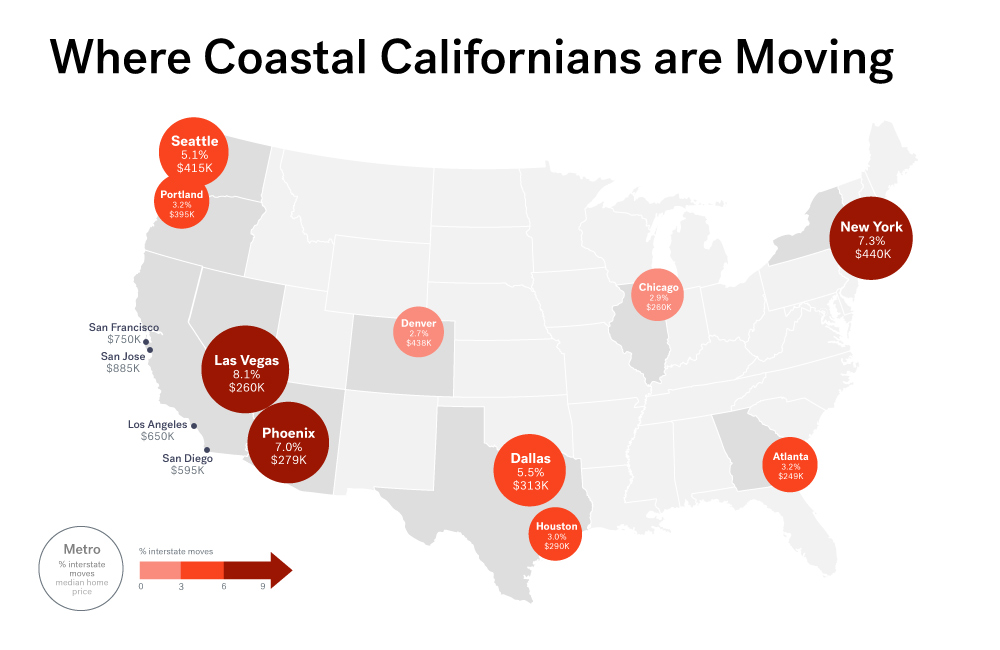Funny thing about housing in the Golden State: you need a lot of gold to live there. As it turns out, in California’s most expensive markets, many are looking to leave – but at the same time, outsiders are looking to come.
We examined where people leaving the costly coastal markets in California are going and how these markets compare to their pricey counterparts. We found:
- Those leaving pricey coastal California end up in a mix of large metropolitan areas, less expensive Sun Belt markets or high job-growth centers.
- There is substantial overlap between the list of top areas where people move and where they were searching on Trulia in the six to 12 months prior to moving.
- Tales of an impending mass exodus from expensive California markets are unsubstantiated from Trulia’s search data since there doesn’t seem to a drop in inbound to outbound visits to properties in these metros.
In this report, we look at San Francisco, San Jose, Los Angeles and San Diego where homes on the market in March 2017 averaged to $720,000 compared to $250,000 nationally. With listing prices across the nation climbing more than 6% annually from 2016 to 2017, these coastal California metros are feeling the heat from rising home prices.
It’s no wonder some Californians are packing their bags and moving elsewhere. Top destination markets for migrants from coastal California metros are to other large metros like New York, Atlanta and Chicago, but also include less expensive Sun Belt markets such as Las Vegas and Phoenix. Californians gravitated to the high job-growth centers of Seattle, Denver, Dallas and Portland, Ore.
These metros were less expensive than coastal California with New York registering the highest median listing price of nearly $440,000 among the top 10 destination markets. We also examined the rank of these destination markets when it came to searches for homes on Trulia from those pricey California markets. We focused on the first six months of 2016, assuming those that moved in the first quarter of 2017 were likely ramping up their home search in that period.
Sure enough, all destination markets but Denver also fell into the top 10 most searched markets on Trulia. Miami is the 10thmost searched market from costly California, but fails to make it into the top 10 list of places where Californians moved. If searches are an indicator of where people tend to go after leaving pricey California markets, then we should keep an eye on Tucson, Ariz., which breaks into the top 10 in terms of search rank in the first half of 2017. Tucson, like Miami, however represents a market that is attractive to retirees so searches may take longer to yield actual moves, and may not show up in the migration data used in this report (see Methodology).

| Destination Metros | Share of All Migrating from Coastal CA to Non-CA Metros, Q1 2017 | Median Listing Price, March 2017
|
Search Rank Based on Share of Trulia Searches from Coastal CA to All Non-CA Metros (Jan-Jun 2016) |
| Las Vegas, NV | 8.1% | $ 260,000 | 1 |
| New York, NY | 7.3% | $ 439,990 | 3 |
| Phoenix, AZ | 7.0% | $ 279,000 | 2 |
| Dallas, TX | 5.5% | $ 312,900 | 4 |
| Seattle, WA | 5.1% | $ 414,950 | 6 |
| Portland, OR | 3.2% | $ 395,000 | 5 |
| Atlanta, GA | 3.2% | $ 249,000 | 8 |
| Houston, TX | 3.0% | $ 289,900 | 9 |
| Chicago, IL | 2.9% | $ 259,800 | 7 |
| Denver, CO | 2.7% | $ 437,500 | 18 |
So, coastal Californians are searching andmoving to similar areas. But has there been an exodus? We wondered if more people are fleeing costly California markets compared to those moving in? To find out, we examined the ratio of inbound to outbound searches for expensive California metros since the start of 2016. If the ratio is 1 that means inbound and outbound searches are equal. In the case of San Diego, inbound searches outweigh outbound, yielding a ratio that is greater than 1. For all other metros, more people are searching out of them than into them, indicating that these are likely the markets where people are more likely to leave.
But are more people headed out of expensive California markets now than ever before? If people were anticipating leaving in droves, we would expect to see a decreasing inbound to outbound ratio. This appears to be the case in San Diego going back to early 2017. However, with San Francisco, San Jose and Los Angeles we simply do not see that sort of drop in searches. So, while this could mean people are looking to leave, a steady number of people are still looking in and keeping that ratio fairly constant. With the net number of inbound to outbound searches remaining relatively steady, high cost living in California is likely not going anywhere soon.
Methodology
Migration data in this report comes from the Longitudinal Employer-Household Dynamics(LEHD) origin and destination job characteristics data from the U.S. Census Bureau. This report focuses on the most recently released data, covering the first quarter of 2017. While this means that the data captures job-to-job moves specifically and may not capture the full picture of migration (e.g. those not in the workforce such as recent graduates and retirees) it spotlights moves that are economically motivated. We feel this is an adequate proxy for general migration trends.
Trulia listing prices are from March 2017 to reflect prices when people moved in the LEHD data, and search data covers the period from January 2016 to April 2018. Inbound searches are defined by searches tothe metro of interest and outbound searches are defined by searches fromthe metro of interest. Searches include views of both for-sale and rental properties on Trulia.
Note that the metros used in this analysis differ from those we typically examine in Trulia Trends reports. Metros included here are Core Based Statistical Areas (CBSAs) since the LEHD defines their origins and destinations using these geographies, whereas we typically report trends at the metropolitan division level. All data, including listing prices and searches has been


